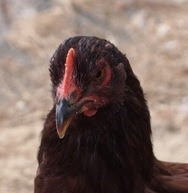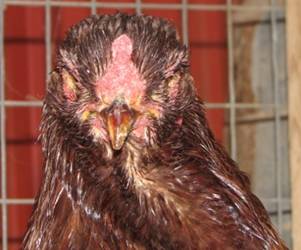As you look through the photos, please remember that each photo is intended to illustrate only ONE element. In other words, many things might be right or wrong with the bird in the photo illustration (since no birds are perfect), but we will only discuss one feature per photo.
We will add to this page as time allows. Let us know what you think!
WHAT HAPPENS TO BIRDS THAT DO NOT MEET THE SOP? The answer is "It all depends". As we have said, there are no "perfect" birds. Every bird has some trait that can be improved upon. However, some problems are more serious than others (as noted below), and birds with serious faults (those likely to be passed down to progeny) are generally removed from breeding programs.
THANK YOU TO PHOTO CONTRIBUTORS! We would like to thank all the photo contributors, especially those that shared photos of less than perfect birds. We all have them, but it takes a confident breeder to show them off!
HEAD STRUCTURE
BEAKS
 |
| Photo 1: Beaks (by Marie Taylor) |
 |
| Photo 2: Beaks (by Shumaker Farm) |
 |
| Photo 3: Beaks (by Shumaker Farm) |
BEAK SHAPE: The birds in Photos 1 through 3 (a cockerel, rooster and hen respectively) have nicely shaped beaks as outlined by the Standard (short, stout, and regularly curved).
The beak of a Buckeye should be thick and strong, resembling that of an Aseel Indian (Cornish) Game (which was used in the development of the breed).
 |
| Photo 4: Beaks (by Marie Taylor) |
 |
| Photo 5: Beaks (by Shumaker Farm) |
COMBS AND WATTLES
 |
| Photo1: Comb and Wattle (by Jeff Lay) |
 |
| Photo 2: Comb and Wattle (by Shumaker Farm) |
COMBS: The cock in Photo 1 and the hen in Photo 2 have nicely defined pea combs. The standard states that a Buckeye should have a pea comb that is set closely on the head (medium in size for males; moderately small for females).
You can see all three rows of the comb in both examples and they are held close to the head, as required. Compare this to the cock and hen in Photos 3 and 4.
 |
| Photo 3: Comb and Wattle (by Marie Taylor) |
 |
| Photo 4: Comb and Wattle (by Shumaker Farm) |
 |
| Photo 5: Comb and Wattle (by Marie Taylor) |
Photo 5 shows a hen with a single comb (not a pea comb as the Standard requires), so using her in a breeding program would be problematic.
EYE COLOR
 |
| Photo1: Eye Color |
 |
| Photo 2: Eye Color |
 |
| Photo 3: Eye Color |
Photos 1 through 4 show a fair representation of the reddish-bay eye color that is acceptable per the 2010 SOP. The SOP has wavered slighting in eye color since the buckeye was introduced in 1905, ranging from a bright red (which is getting harder to find in the Buckeye) to the present description of a reddish-bay. Eye color that is anywhere in this range is acceptable.
It is important to maintain the standard eye color and stray away from light orange and yellow (Photos 5 and 6), and green eye colors (which do arise).
 |
| Photo 5: Eye Color |
 |
| Photo 6: Eye Color |
HEAD WIDTH
 |
| Photo1: Head Width (by Shumaker Farm) |
 |
| Photo 2: Head Width (by Shumaker Farm) |
 |
| Photo 3: Head Width (by Shumaker Farm) |
The width and shape of a Buckeye’s head should reflect its Asiatic heritage (as mentioned earlier, the Aseel Indian Game was used in the development of the breed) by having a well-rounded head and wide skull structure.
There should also be a moderate brow ridge above the eye which the eye sits under (like a bird of prey) as illustrated in Photos 1 through 3.
Thin and elongated heads, as shown in Photos 4 and 5, should be avoided.
 |
| Photo 4: Head Width (by Shumaker Farm) |
 |
| Photo 5: Head Width (by Marie Taylor) |
FEATHER COLOR
EXTERIOR BODY COLOR
 |
| Buckeye Nuts |
However, there has been much debate over how dark the feather color should be. The 2010 SOP suggests the general surface color be an even shade of “rich mahogany bay” in all sections, with the exception that the unexposed primaries and secondaries, and the main tail feathers may contain black. This definition is fairly broad, but many breeders feel the description of “mahogany bay” is not accurate as it brings to mind a color that is much lighter than the Buckeye nut.
In an article published by The American Buckeye Club in 1916, Nettie Metcalf stated, “As for color—well, my own are so dark a red that at a little distance in the shadow they look fairly black, but when the sun strikes them and brings out that rich, garnish luster…”. A respectable example of this color transformation is illustrated in Photos 1 and 2, and suggests that the color envisioned by Nettie was a dark, deep mahogany, not a "mahogany bay". Thus, Judges seem to waver in opinion between a mahogany bay and a deep mahogany body color.
 |
| Photo1: Body Color (by Sumaker Farm) |
 |
| Photo 2: Body Color (by Shumaker Farm) |
The ABC believes that the males in Photos 1 through 4 and the pullet in Photo 5 exhibit the dark red color envisioned by Nettie in the original SOP.
 |
| Photo 3: Body Color (by Marie Taylor) |
 |
| Photo 4: Body Color (by Shumaker Farm) |
 |
| Photo 5: Body Color (by Shumaker Farm) |
 |
| Photo 6: Body Color (by Marie Taylor) |
In contrast, you can see that the hens in Photo 6 have a mottled appearance caused by lighter red feathers intermixed with darker feathers. This is not an acceptable coloration per either the 1905 or 2010 SOP, so these hens may not be the best choice for breeding.
 |
| Photo 7: Body Color (by Shumaker Farm) |
As to the issue of white feathers, all are in agreement. As Nettie Metcalf mentioned in the aforementioned article (The 1916 edition of the ABC catalogue), “white feathers are something we despise above all other defects”. The 2010 SOP references that one or more entirely white feather showing in the outer plumage is considered a disqualification. The 1905 SOP seems to indicate that even a partial white feather would be a disqualification.
UNDERCOLOR
 |
| Photo 1: Undercolor (by Shumaker Farms) |
 |
| Photo 2: Undercolor (by Shumaker Farm) |
When looking at a Buckeye one cannot help but notice the beautiful dark mahogany sheen of their plumage.
This dark sheen is mainly attributed to the "bar of slate" (undercolor) that is beneath the exterior plumage. It shows as a charcoal grey color (as shown in Photos 1 through 3).
This special undercolor (often referred to as “smutt” by poultry judges) is mentioned in both the 1905 and 2010 SOP, and was specifically called out by Nettie Metcalf in her early journal discussions about plumage color. The darker the undercolor, the darker the bird.
 |
| Photo 3: Undercolor (by Shumaker Farms) |
 |
| Photo 4: Undercolor (by Shumaker Farms) |
Many of today's Buckeyes don't have this undercolor. Instead, the feathers are a light red all the way to the base of the feather (as shown in Photo 4). This is leading to Buckeyes becoming lighter in surface color, and should be avoided.
STRUCTURAL CONFORMATION
STATION AND BODY SHAPE
 |
| Photo 1: Station (by Marie Taylor) |
 |
| Photo 2: Station (by Shumaker Farm) |
 |
| Photo 3: Station (by Shumaker Farm) |
 |
| Photo 4: Station (by Shumaker Farm) |
 |
| Photo 5: Station (by Shumaker Farm) |
The keel is expected to be long, extending well forward with the fluff moderately full. These features are observed with the pullet in Photo 5.
 |
| Photo 6: Station (by Marie Taylor) |
Photo 6 is a great example of a split wing. This defect is a genetic trait that is a disqualification (per the Standard). Birds that possess this trait should be removed from all breeding programs.
TAIL CARRIAGE
 |
| Photo1: Tail (by Shumaker Farm) |
 |
| Photo 2: Tail (by Shumaker Farm) |
MALE: Photos 1 and 2 are representative of how a cock should carry their tail and how the tail feathers should unfold or spread out.
As the standard suggests, the tail should be of medium length and size, carried moderately upright (roughly 40 degrees above the horizon). Sickles and coverts (secondary feathers) should be of medium length, nicely curved, and sufficiently abundant to cover the stiff primary feathers. Sickles and coverts should be shaded bay and black to avoid a sharp contrast between the body and tail. Pinched tails and excessively long secondary feathers are to be avoided.
Note that the camera flash shows the sheen of the tail feathers in Photo 2, making them look grey. This is one of the traits that separate the Buckeye from the Rhode Island Red, and illustrates that the feathers are not dull in color.
 |
| Photo 3: Tail (by Shumaker Farm) |
 |
| Photo 4: Tail (by Shumaker Farm) |
FEMALE: Photos 3 and 4 are representative of how a female should carry its tail and how the tail feathers should unfold or spread out. Note the color of the hen in Photo 4 is very light. This is due to the hen's age.
The female tail should be medium in length, fairly well-spread, carried at an angle of thirty degrees (30°) above horizontal.
